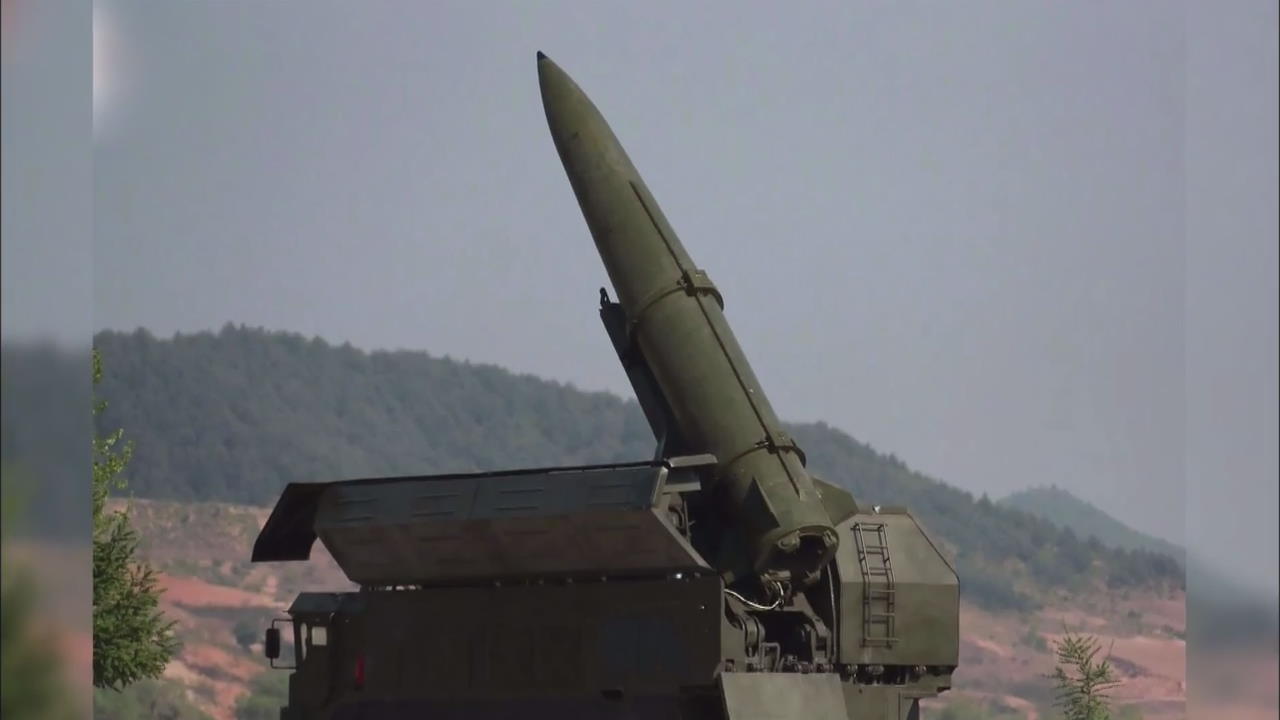SHORT-RANGE PROJECTILES
입력 2019.05.14 (15:14)
수정 2019.05.14 (16:46)
읽어주기 기능은 크롬기반의
브라우저에서만 사용하실 수 있습니다.
[Anchor Lead]
The South Korean military has virtually concluded that the short-range projectile fired by North Korea last week, is a ballistic missile. However, it remains cautious about reaching a final conclusion, since the missile could be a new type of weapon able to avoid interception and Seoul would need to draw up a new missile defense system, depending on situational developments.
[Pkg]
An enlarged photo of a short-range missile fired by North Korea on May 9. The Korean letter "ㅈ" can be seen along with an apparent serial number. Seoul's military presumes the letter indicates North Korea's strategic forces that operate ballistic missiles. The letter appeared multiple times on ballistic missiles launched by the regime.
[Soundbite] (MILITARY PARADE MARKING 70th ANNIV. OF N. KOREAN ARMY (FEB, 2018)) : "Strategic troops are passing by the parade plaza."
Despite its stance that it is still in the process of analysis, the South Korean military is known to have virtually concluded that the recently fired projectile is a ballistic missile. It is highly likely that North Korea has developed a new type of short-range ballistic missile. It's highly likely an upgraded version of the KN-O2. The newly fired missile flies at a low altitude of 40 to 50 kilometers, like the KN-O2. But it can cover 400 kilometers, a two-fold increase from the previous model's range of 200 kilometers. It means South Korea is in the missile's range. Intercepting this type of missile can be very challenging. The nation's military is paying particular attention to the fact that the new missile's trajectory is different from that of previous ballistic missiles, which fly in an arc. The difference suggests Pyongyang could have developed and applied an advanced guided missile technology, which pinpoints the target in the final stage of its flight, like Russia's Iskander ballistic missile.
[Soundbite] CHOI HYUN-SOO(MIN. OF NATIONAL DEFENSE SPOKESPERSON (MAY 13)) : "More detailed analysis is needed, as the missile's type and other specifications had been unknown before. The analysis will take longer than expected."
South Korea's current missile interception system is less effective in thwarting such cutting-edge guided missiles. It will be inevitable for Seoul to develop and employ a new missile defense system.
The South Korean military has virtually concluded that the short-range projectile fired by North Korea last week, is a ballistic missile. However, it remains cautious about reaching a final conclusion, since the missile could be a new type of weapon able to avoid interception and Seoul would need to draw up a new missile defense system, depending on situational developments.
[Pkg]
An enlarged photo of a short-range missile fired by North Korea on May 9. The Korean letter "ㅈ" can be seen along with an apparent serial number. Seoul's military presumes the letter indicates North Korea's strategic forces that operate ballistic missiles. The letter appeared multiple times on ballistic missiles launched by the regime.
[Soundbite] (MILITARY PARADE MARKING 70th ANNIV. OF N. KOREAN ARMY (FEB, 2018)) : "Strategic troops are passing by the parade plaza."
Despite its stance that it is still in the process of analysis, the South Korean military is known to have virtually concluded that the recently fired projectile is a ballistic missile. It is highly likely that North Korea has developed a new type of short-range ballistic missile. It's highly likely an upgraded version of the KN-O2. The newly fired missile flies at a low altitude of 40 to 50 kilometers, like the KN-O2. But it can cover 400 kilometers, a two-fold increase from the previous model's range of 200 kilometers. It means South Korea is in the missile's range. Intercepting this type of missile can be very challenging. The nation's military is paying particular attention to the fact that the new missile's trajectory is different from that of previous ballistic missiles, which fly in an arc. The difference suggests Pyongyang could have developed and applied an advanced guided missile technology, which pinpoints the target in the final stage of its flight, like Russia's Iskander ballistic missile.
[Soundbite] CHOI HYUN-SOO(MIN. OF NATIONAL DEFENSE SPOKESPERSON (MAY 13)) : "More detailed analysis is needed, as the missile's type and other specifications had been unknown before. The analysis will take longer than expected."
South Korea's current missile interception system is less effective in thwarting such cutting-edge guided missiles. It will be inevitable for Seoul to develop and employ a new missile defense system.
■ 제보하기
▷ 카카오톡 : 'KBS제보' 검색, 채널 추가
▷ 전화 : 02-781-1234, 4444
▷ 이메일 : kbs1234@kbs.co.kr
▷ 유튜브, 네이버, 카카오에서도 KBS뉴스를 구독해주세요!
- SHORT-RANGE PROJECTILES
-
- 입력 2019-05-14 15:23:18
- 수정2019-05-14 16:46:03

[Anchor Lead]
The South Korean military has virtually concluded that the short-range projectile fired by North Korea last week, is a ballistic missile. However, it remains cautious about reaching a final conclusion, since the missile could be a new type of weapon able to avoid interception and Seoul would need to draw up a new missile defense system, depending on situational developments.
[Pkg]
An enlarged photo of a short-range missile fired by North Korea on May 9. The Korean letter "ㅈ" can be seen along with an apparent serial number. Seoul's military presumes the letter indicates North Korea's strategic forces that operate ballistic missiles. The letter appeared multiple times on ballistic missiles launched by the regime.
[Soundbite] (MILITARY PARADE MARKING 70th ANNIV. OF N. KOREAN ARMY (FEB, 2018)) : "Strategic troops are passing by the parade plaza."
Despite its stance that it is still in the process of analysis, the South Korean military is known to have virtually concluded that the recently fired projectile is a ballistic missile. It is highly likely that North Korea has developed a new type of short-range ballistic missile. It's highly likely an upgraded version of the KN-O2. The newly fired missile flies at a low altitude of 40 to 50 kilometers, like the KN-O2. But it can cover 400 kilometers, a two-fold increase from the previous model's range of 200 kilometers. It means South Korea is in the missile's range. Intercepting this type of missile can be very challenging. The nation's military is paying particular attention to the fact that the new missile's trajectory is different from that of previous ballistic missiles, which fly in an arc. The difference suggests Pyongyang could have developed and applied an advanced guided missile technology, which pinpoints the target in the final stage of its flight, like Russia's Iskander ballistic missile.
[Soundbite] CHOI HYUN-SOO(MIN. OF NATIONAL DEFENSE SPOKESPERSON (MAY 13)) : "More detailed analysis is needed, as the missile's type and other specifications had been unknown before. The analysis will take longer than expected."
South Korea's current missile interception system is less effective in thwarting such cutting-edge guided missiles. It will be inevitable for Seoul to develop and employ a new missile defense system.
The South Korean military has virtually concluded that the short-range projectile fired by North Korea last week, is a ballistic missile. However, it remains cautious about reaching a final conclusion, since the missile could be a new type of weapon able to avoid interception and Seoul would need to draw up a new missile defense system, depending on situational developments.
[Pkg]
An enlarged photo of a short-range missile fired by North Korea on May 9. The Korean letter "ㅈ" can be seen along with an apparent serial number. Seoul's military presumes the letter indicates North Korea's strategic forces that operate ballistic missiles. The letter appeared multiple times on ballistic missiles launched by the regime.
[Soundbite] (MILITARY PARADE MARKING 70th ANNIV. OF N. KOREAN ARMY (FEB, 2018)) : "Strategic troops are passing by the parade plaza."
Despite its stance that it is still in the process of analysis, the South Korean military is known to have virtually concluded that the recently fired projectile is a ballistic missile. It is highly likely that North Korea has developed a new type of short-range ballistic missile. It's highly likely an upgraded version of the KN-O2. The newly fired missile flies at a low altitude of 40 to 50 kilometers, like the KN-O2. But it can cover 400 kilometers, a two-fold increase from the previous model's range of 200 kilometers. It means South Korea is in the missile's range. Intercepting this type of missile can be very challenging. The nation's military is paying particular attention to the fact that the new missile's trajectory is different from that of previous ballistic missiles, which fly in an arc. The difference suggests Pyongyang could have developed and applied an advanced guided missile technology, which pinpoints the target in the final stage of its flight, like Russia's Iskander ballistic missile.
[Soundbite] CHOI HYUN-SOO(MIN. OF NATIONAL DEFENSE SPOKESPERSON (MAY 13)) : "More detailed analysis is needed, as the missile's type and other specifications had been unknown before. The analysis will take longer than expected."
South Korea's current missile interception system is less effective in thwarting such cutting-edge guided missiles. It will be inevitable for Seoul to develop and employ a new missile defense system.
이 기사가 좋으셨다면
-
좋아요
0
-
응원해요
0
-
후속 원해요
0















![[단독] 한강버스 운항 두 달 남았는데…일부 공정률 ‘절반 이하’](/data/news/2025/07/01/20250701_LmwC7h.jpg)

이 기사에 대한 의견을 남겨주세요.